六年级上册英语知识总结
完整版)人教版六年级英语上册知识点汇总总结提纲
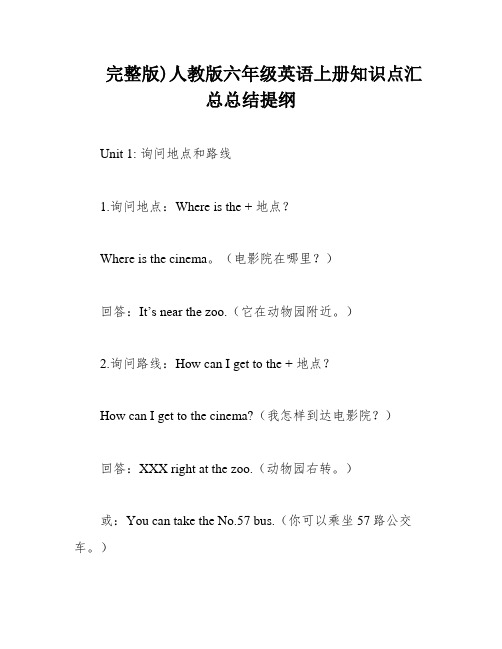
完整版)人教版六年级英语上册知识点汇总总结提纲Unit 1: 询问地点和路线1.询问地点:Where is the + 地点?Where is the cinema。
(电影院在哪里?)回答:It’s near the zoo.(它在动物园附近。
)2.询问路线:How can I get to the + 地点?How can I get to the cinema?(我怎样到达电影院?)回答:XXX right at the zoo.(动物园右转。
)或:You can take the No.57 bus.(你可以乘坐57路公交车。
)Unit 2: 交通方式1.询问某人怎样去某地:How do某人go(come) to + 地点?How do you go to school?(你怎么去学校?)回答:I go to school on foot.(我走路去学校。
)2.规定某人必须做某事:某人 + must + 动词原形XXX.(骑自行车的人必须戴头盔。
)I must pay n to the traffic XXX.(我必须注意交通信号灯。
)Unit 3: 打算做某事某人 + be going to + do(动词原形)She is going to see a film.(她打算去看电影。
)My uncle is planningXXX to go to the supermarket。
In this unit。
there are several types of ns that we can use to XXX。
For example。
we can ask "What are you going to do (+time or place)?" or "When are you going (+place)?" to get an XXX may include phrases such as "I am going to the cinema tomorrow" or "They are going to Nanjing next week."Similarly。
人教版六年级上册英语知识点汇总
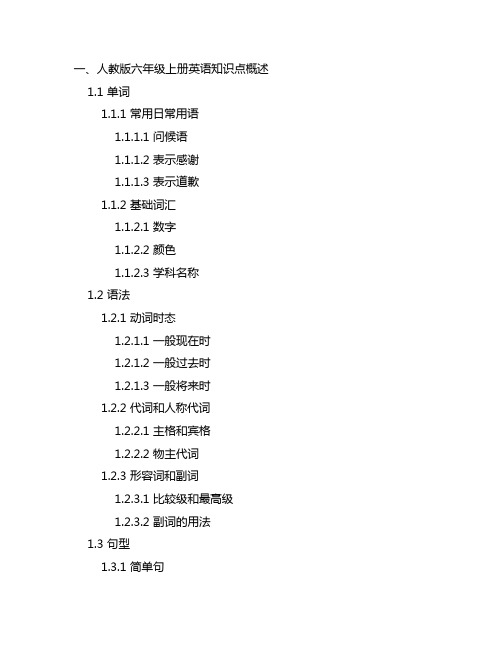
一、人教版六年级上册英语知识点概述1.1 单词1.1.1 常用日常用语1.1.1.1 问候语1.1.1.2 表示感谢1.1.1.3 表示道歉1.1.2 基础词汇1.1.2.1 数字1.1.2.2 颜色1.1.2.3 学科名称1.2 语法1.2.1 动词时态1.2.1.1 一般现在时1.2.1.2 一般过去时1.2.1.3 一般将来时1.2.2 代词和人称代词1.2.2.1 主格和宾格1.2.2.2 物主代词1.2.3 形容词和副词1.2.3.1 比较级和最高级1.2.3.2 副词的用法1.3 句型1.3.1 简单句1.3.1.1 肯定句1.3.1.2 否定句1.3.1.3 疑问句1.3.2 复合句1.3.2.1 并列句1.3.2.2 定语从句1.3.2.3 状语从句二、人教版六年级上册英语知识点详解2.1 单词2.1.1 常用日常用语2.1.1.1 问候语问候语是指在英语日常交际中用于打招呼和示好的常用词汇,包括Hello、Hi、Good morning、Good afternoon等等。
2.1.1.2 表示感谢表示感谢的常用词汇有Thank you、Thanks a lot、Thank you very much等,用于表达对别人的帮助或礼物表示感激之情。
2.1.1.3 表示道歉表示道歉的词汇包括I'm sorry、Excuse me、Pardon等,在日常生活中,用于向别人道歉或请求对方让步的场合。
2.1.2 基础词汇2.1.2.1 数字数字是英语基础词汇的重要部分,包括基本的数字表达方式和计量单位,如one、two、three等,以及hundred、thousand等。
2.1.2.2 颜色颜色是描述事物外观的重要词汇,在日常交流中也经常用到,包括red、blue、yellow等常见颜色词汇。
2.1.2.3 学科名称学科名称涉及到人们日常生活和学习工作的方方面面,包括mathematics、music、art等,是学习英语时必须掌握的词汇。
英语六年级上册期末知识点总结

英语六年级上册期末知识点总结英语六年级上册期末知识1一、单词line(等候的)长队,队列stand in line排队close关门,关闭librarian图书馆管理员rule规定,规章quiet安静的problem麻烦,困难,问题No problem没问题cross穿过(马路等);渡过(河)二、短语:1.帮助我 Help me2. Don’t walk! 不要走3. in line 成一条直线4. be quiet 安静!5. go to the library 去图书馆6. at the library在图书馆(强调地点)7. Here`s the book.这本书在这儿、8. ten to five 4点五十9. the library rules 图书馆规定10. library card 借书卡11. turn right 向右转向左转 turn left12. Please hurry 请快点13. go straight on 直走14. be difficult是难的15. be easy 是容易的16. Don`t go !禁止前行/不要走!17. Don`t walk!禁止步行!18. It`s green now.现在是绿灯了。
19. Don`t ride your bicycle here!此处禁止骑自行车!20. Don`t turn right here!此处禁止右转!21. Please hurry.请快点/请抓紧。
22. Don`t walk on the grass!禁止踩踏草坪!23. clap your hands拍手24. stamp your feet跺脚25. want to show it.想展示出来26. You`re out!你出局了!27 It says, “Don’t talk in the library”不要在图书馆里交谈Don’t= do not三、句型:1.Where are you going,Simon?To the library.Please hurry.It`s ten to five.西蒙,你要去哪里?去图书馆。
小学六年级上册英语知识点归纳总结
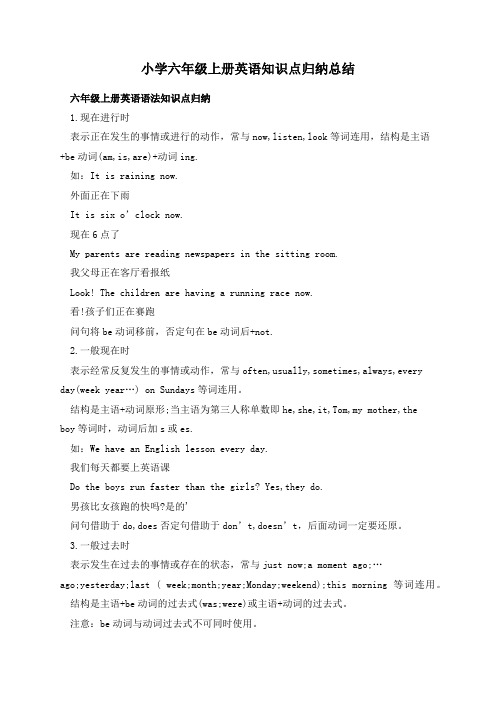
小学六年级上册英语知识点归纳总结六年级上册英语语法知识点归纳1.现在进行时表示正在发生的事情或进行的动作,常与now,listen,look等词连用,结构是主语+be动词(am,is,are)+动词ing.如:It is raining now.外面正在下雨It is six o’clock now.现在6点了My parents are reading newspapers in the sitting room.我父母正在客厅看报纸Look! The children are having a running race now.看!孩子们正在赛跑问句将be动词移前,否定句在be动词后+not.2.一般现在时表示经常反复发生的事情或动作,常与often,usually,sometimes,always,every day(week year…) on Sundays等词连用。
结构是主语+动词原形;当主语为第三人称单数即he,she,it,Tom,my mother,theboy等词时,动词后加s或es.如:We have an English lesson every day.我们每天都要上英语课Do the boys run faster than the girls? Yes,they do.男孩比女孩跑的快吗?是的'问句借助于do,does否定句借助于don’t,doesn’t,后面动词一定要还原。
3.一般过去时表示发生在过去的事情或存在的状态,常与just now;a moment ago;…ago;yesterday;last ( week;month;year;Monday;weekend);this morning等词连用。
结构是主语+be动词的过去式(was;were)或主语+动词的过去式。
注意:be动词与动词过去式不可同时使用。
如:My earphones were on the ground just now.我的耳机刚刚还在呢。
六年级上册英语单元知识点总结
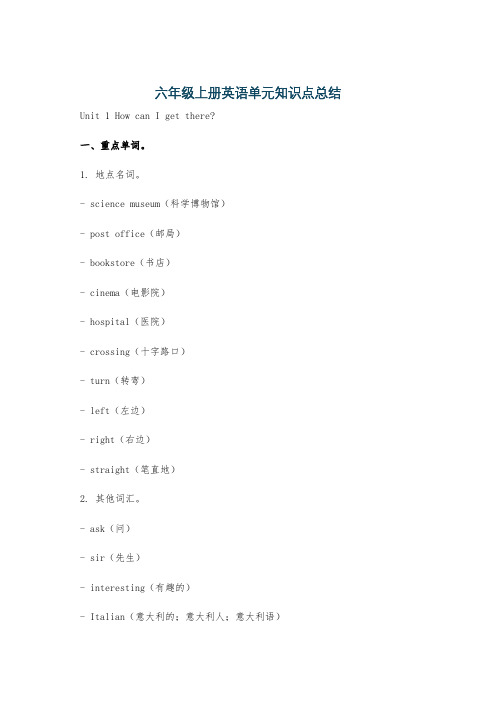
六年级上册英语单元知识点总结Unit 1 How can I get there?一、重点单词。
1. 地点名词。
- science museum(科学博物馆)- post office(邮局)- bookstore(书店)- cinema(电影院)- hospital(医院)- crossing(十字路口)- turn(转弯)- left(左边)- right(右边)- straight(笔直地)2. 其他词汇。
- ask(问)- sir(先生)- interesting(有趣的)- Italian(意大利的;意大利人;意大利语)- restaurant(餐馆)- pizza(比萨饼)- street(大街;街道)- get(到达)- GPS(全球定位系统)- gave(give的过去式,提供;交给)- feature(特点)- follow(跟着)- far(远的)- tell(告诉)二、重点短语。
1. 问路相关。
- turn left(向左转)- turn right(向右转)- go straight(直走)- in front of(在……前面)- next to(紧挨着)- near(在……附近)- behind(在……后面)2. 到达某地的表达。
- get to(到达),例如:get to the park(到达公园)- arrive at(到达小地点,如:arrive at the cinema到达电影院)- arrive in(到达大地点,如:arrive in Beijing到达北京)三、重点句型。
1. 问路句型。
- Where is the + 地点? 例如:Where is the post office?(邮局在哪里?)- How can I get to the + 地点? 例如:How can I get to the bookstore?(我如何能到达书店?)2. 指路句型。
六年级上册英语知识点归纳
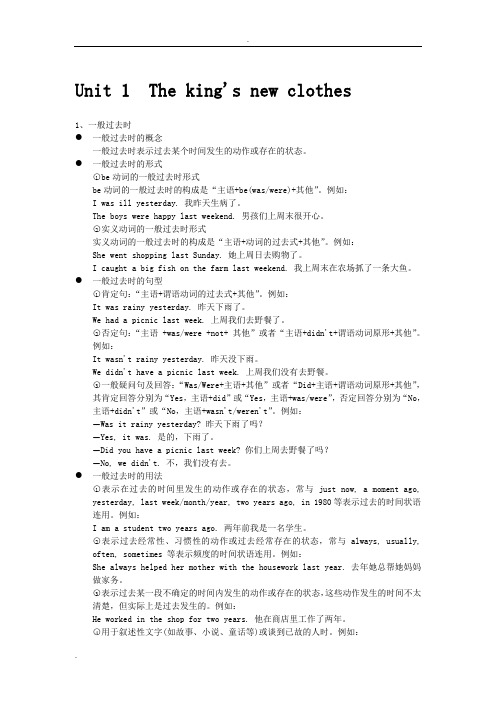
Unit 1 The king's new clothes1、一般过去时●一般过去时的概念一般过去时表示过去某个时间发生的动作或存在的状态。
●一般过去时的形式○1be动词的一般过去时形式be动词的一般过去时的构成是“主语+be(was/were)+其他”。
例如:I was ill yesterday. 我昨天生病了。
The boys were happy last weekend. 男孩们上周末很开心。
○2实义动词的一般过去时形式实义动词的一般过去时的构成是“主语+动词的过去式+其他”。
例如:She went shopping last Sunday. 她上周日去购物了。
I caught a big fish on the farm last weekend. 我上周末在农场抓了一条大鱼。
●一般过去时的句型○1肯定句:“主语+谓语动词的过去式+其他”。
例如:It was rainy yesterday. 昨天下雨了。
We had a picnic last week. 上周我们去野餐了。
○2否定句:“主语 +was/were +not+ 其他”或者“主语+didn't+谓语动词原形+其他”。
例如:It wasn't rainy yesterday. 昨天没下雨。
We didn't have a picnic last week. 上周我们没有去野餐。
○3一般疑问句及回答:“Was/Were+主语+其他”或者“Did+主语+谓语动词原形+其他”,其肯定回答分别为“Yes,主语+did”或“Yes,主语+was/were”,否定回答分别为“No,主语+didn't”或“No,主语+wasn't/weren't”。
例如:—Was it rainy yesterday? 昨天下雨了吗?—Yes, it was. 是的,下雨了。
—Did you have a picnic last week? 你们上周去野餐了吗?—No, we didn't. 不,我们没有去。
六年级上册英语一到六单元知识总结
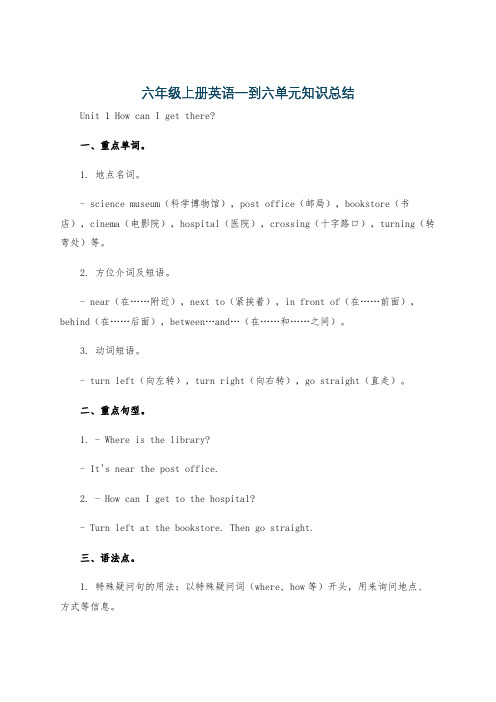
六年级上册英语一到六单元知识总结Unit 1 How can I get there?一、重点单词。
1. 地点名词。
- science museum(科学博物馆),post office(邮局),bookstore(书店),cinema(电影院),hospital(医院),crossing(十字路口),turning(转弯处)等。
2. 方位介词及短语。
- near(在……附近),next to(紧挨着),in front of(在……前面),behind(在……后面),between…and…(在……和……之间)。
3. 动词短语。
- turn left(向左转),turn right(向右转),go straight(直走)。
二、重点句型。
1. - Where is the library?- It's near the post office.2. - How can I get to the hospital?- Turn left at the bookstore. Then go straight.三、语法点。
1. 特殊疑问句的用法:以特殊疑问词(where, how等)开头,用来询问地点、方式等信息。
2. 一般现在时在问路指路中的运用。
Unit 2 Ways to go to school.一、重点单词。
1. 交通工具名词。
- by bike(骑自行车),by bus(乘公共汽车),by train(乘火车),by plane(乘飞机),on foot(步行),ship(轮船),subway(地铁)等。
2. 形容词。
- slow(慢的),fast(快的)。
3. 其他。
- traffic(交通),traffic lights(交通灯),stop(停),wait(等)。
二、重点句型。
1. - How do you come to school?- Usually, I come on foot.2. - How can I get to the Fuxing Hospital?- Take the No. 57 bus over there.三、语法点。
六年级英语上册知识点总汇

六年级英语上册知识点总汇一、介词与介词短语1. 常见介词介词是连接名词、代词或动词与其宾语之间关系的词语。
六年级上册中常见的介词有:in、on、at、to、from、for、with等。
2. 介词短语的用法介词短语由介词和其宾语构成,常用来表示时间、地点、原因、目的等。
例如:in the morning(在早晨)、at school(在学校)、from Monday to Friday(从星期一到星期五)等。
二、时态与语态1. 一般现在时一般现在时表示经常性、习惯性或普遍性的动作或状态。
句子结构为主语 + 动词原形,例如:She likes swimming.(她喜欢游泳。
)2. 一般过去时一般过去时表示过去发生的动作或状态。
句子结构为主语 + 动词过去式,例如:They visited the museum last week.(他们上周参观了博物馆。
)3. 一般将来时一般将来时表示将要发生的动作或状态。
句子结构为主语 + will + 动词原形,例如:I will go to the park tomorrow.(我明天将去公园。
)4. 被动语态被动语态表示主语是动作的承受者。
句子结构为主语 + be + 过去分词,例如:The book was written by Mark Twain.(这本书是马克·吐温写的。
)三、名词与数词1. 可数名词与不可数名词可数名词指可以计数的名词,可以有单数和复数形式;不可数名词则不能计数,只有单数形式。
例如:a pen(一支笔,可数名词)、water(水,不可数名词)等。
2. 名词所有格名词所有格表示所属关系,通常在名词后加's构成。
例如:Tom's book(汤姆的书)。
3. 基数词与序数词基数词表示数量或顺序,例如:one、two、three等;序数词表示顺序,例如:first、second、third等。
四、形容词与副词1. 形容词的比较级和最高级形容词的比较级表示两个事物之间的比较,结构为形容词 + er + than,例如:taller than(比...更高);最高级表示三个或三个以上事物中的最高级,结构为the + 形容词的最高级,例如:the tallest(最高的)。
六年级英语上册各单元知识点归类总结
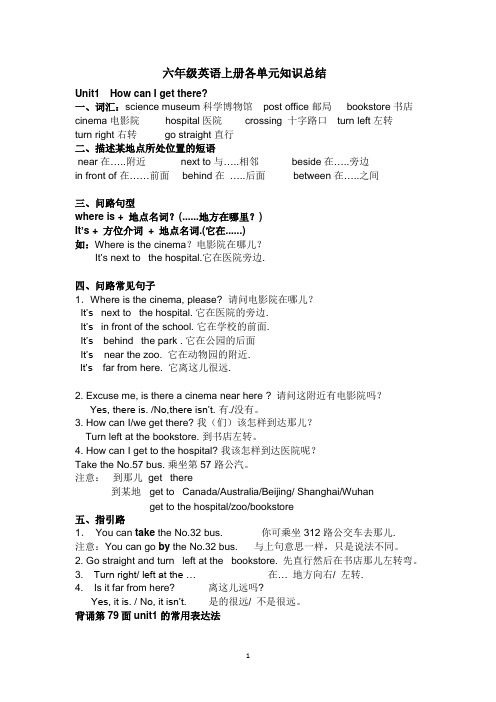
六年级英语上册各单元知识总结Unit1 How can I get there?一、词汇:science museum科学博物馆post office 邮局bookstore书店cinema电影院hospital医院crossing 十字路口turn left左转turn right右转go straight直行二、描述某地点所处位置的短语near在…..附近next to与…..相邻beside在…..旁边in front of 在……前面behind在…..后面between 在…..之间三、问路句型where is + 地点名词?(......地方在哪里?)It’s + 方位介词+ 地点名词.(它在......)如:Where is the cinema?电影院在哪儿?It’s next to the hospital.它在医院旁边.四、问路常见句子1.Where is the cinema, please? 请问电影院在哪儿?It’s next to the hospital. 它在医院的旁边.It’s in front of the school. 它在学校的前面.It’s behind the park . 它在公园的后面It’s near the zoo. 它在动物园的附近.It’s far from here. 它离这儿很远.2. Excuse me, is there a cinema near here ? 请问这附近有电影院吗?Yes, there is. /No,there isn’t.有./没有。
3. How can I/we get there? 我(们)该怎样到达那儿?Turn left at the bookstore. 到书店左转。
4. How can I get to the hospital? 我该怎样到达医院呢?Take the No.57 bus. 乘坐第57路公汽。
英语六年级上册重点知识总结
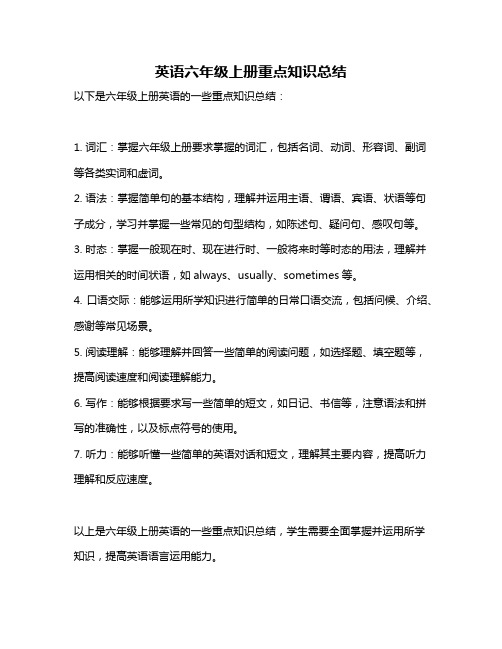
英语六年级上册重点知识总结
以下是六年级上册英语的一些重点知识总结:
1. 词汇:掌握六年级上册要求掌握的词汇,包括名词、动词、形容词、副词等各类实词和虚词。
2. 语法:掌握简单句的基本结构,理解并运用主语、谓语、宾语、状语等句子成分,学习并掌握一些常见的句型结构,如陈述句、疑问句、感叹句等。
3. 时态:掌握一般现在时、现在进行时、一般将来时等时态的用法,理解并运用相关的时间状语,如always、usually、sometimes等。
4. 口语交际:能够运用所学知识进行简单的日常口语交流,包括问候、介绍、感谢等常见场景。
5. 阅读理解:能够理解并回答一些简单的阅读问题,如选择题、填空题等,提高阅读速度和阅读理解能力。
6. 写作:能够根据要求写一些简单的短文,如日记、书信等,注意语法和拼写的准确性,以及标点符号的使用。
7. 听力:能够听懂一些简单的英语对话和短文,理解其主要内容,提高听力理解和反应速度。
以上是六年级上册英语的一些重点知识总结,学生需要全面掌握并运用所学知识,提高英语语言运用能力。
小学六年级英语上册知识点总结
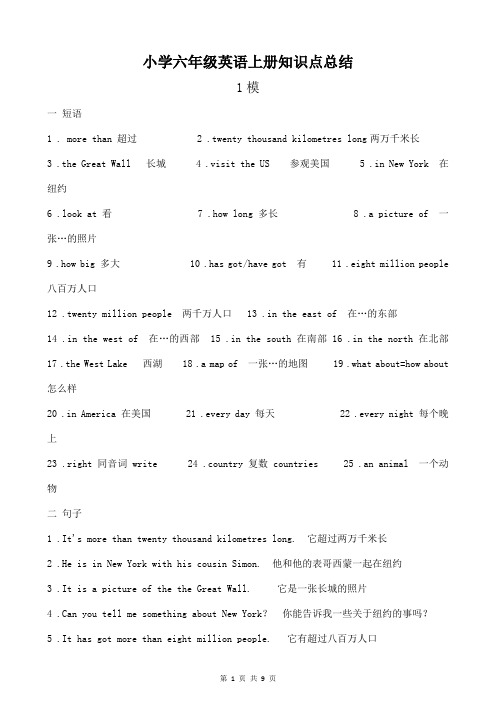
小学六年级英语上册知识点总结1模一短语1 . more than 超过2 .twenty thousand kilometres long两万千米长3 .the Great Wall 长城4 .visit the US 参观美国5 .in New York 在纽约6 .look at 看7 .how long 多长8 .a picture of 一张…的照片9 .how big 多大 10 .has got/have got 有 11 .eight million people 八百万人口12 .twenty million people 两千万人口 13 .in the east of 在…的东部14 .in the west of 在…的西部 15 .in the south 在南部16 .in the north 在北部17 .the West Lake 西湖 18 .a map of 一张…的地图 19 .what about=how about 怎么样20 .in America 在美国 21 .every day 每天 22 .every night 每个晚上23 .right 同音词 write 24 .country 复数 countries 25 .an animal 一个动物二句子1 .It's more than twenty thousand kilometres long. 它超过两万千米长2 .He is in New York with his cousin Simon. 他和他的表哥西蒙一起在纽约3 .It is a picture of the the Great Wall. 它是一张长城的照片4 .Can you tell me something about New York?你能告诉我一些关于纽约的事吗?5 .It has got more than eight million people. 它有超过八百万人口6 .Beijing has got about twenty million people. 北京大约有两千万人口7 .It is in the west. 它是在西部8 .It's in the east of China. 它是在中国的东部9 .What a big map of the US!多么大的一张美国地图啊!2 模一短语1 .Chinese dancing 中国的舞蹈2 .any 用于否定句或一般疑问句中3 .in China 在中国4 .send an email 发送一封电子邮件5 .send sb sth=send sth to sb 给某人发送或邮寄某物6 .want sth 想要某物7 .want to do sth 想要做某事 8 .let's=let us 后加动词原形让我们9 .there 对应词 here 10 .the Changjiang River 长江11 .the Huangshan Mountain 黄山 12 .in the street 在大街上二句子1 .There is Chinese dancing. 有中国的舞蹈2 .There's a Chinatown in New York. 在纽约有一个唐人街3 .I'm sending an email to my family in China.我正在给我在中国的家人发送一个电子邮件4 .Do you want to go to Chinatown?你想要去唐人街吗?5 .Let's go to Chinatown. 让我们去唐人街吧6 .There are lots of beautiful lakes in China. 在中国有许多漂亮的湖7 .This is the famous Changjiang River. 这是著名的长江3模一词组1 .collect stamps 收集邮票2 .all of these stamps 所有的这些邮票3 .another Chinese stamp 另一张中国邮票4 .collect dolls 收集玩具娃娃6 .picture books 图画书7 .fly a kite=fly kites 放风筝8 .Chinese kites 中国的风筝9 .dragon kites 龙风筝 10 .ride a bike=ride bikes 骑自行车11 .play a game= play games 玩游戏 12 .collect toy cars 收集玩具汽车二句子1 .Collecting stamps is my hobby. 收集邮票是我的业余爱好2 .These are stamps from Canada. 这些是来自于加拿大的邮票3 .Have you got any stamps from China?你有一些来自于中国的邮票吗?4 .These stamps are from my letter. 这些邮票是来自于我的信5 .Is there a letter for me?有一封给我的信吗?6 .What's your hobby?你的爱好是什么?7 .Flying kites is my hobby. 放风筝是我的爱好8 .Taking pictures is my hobby. 拍照是我的爱好9 .Do you collect stamps?你收集邮票吗?4模一短语1 .my favourite festival 我最喜欢的节日2 .on Thanksgiving Day 在感恩节3 .on Flag Day 在国旗制定纪念日4 .fly the flag 升国旗5 .sing songs 唱国歌6 . after Thanksgiving dinner 感恩晚餐之后7 .American festival 美国的节目8 .have a special meal 吃一顿特殊的饭9 .on TV 在电视上10 .the Spring Festival 春节 11.eat moon cakes 吃月饼12 .at the Mid-Autumn Festival 在中秋节 13 .at the Dragon Boat Festival 在端午节14 .see the dragon boat race 看龙舟比赛 15 .hang lanterns 挂灯笼16 .do dragon dances 舞龙 17 .hang 过去式 hung二句子1 .Thanksgiving is my favourite festival. 感恩节是我最喜欢的节日2 .On Thanksgiving Day we say “thank you”for our food ,family and friend.在感恩节,我们对我们的食物,家人,朋友说谢谢你。
(精心归纳总结)六年级英语上册重点知识
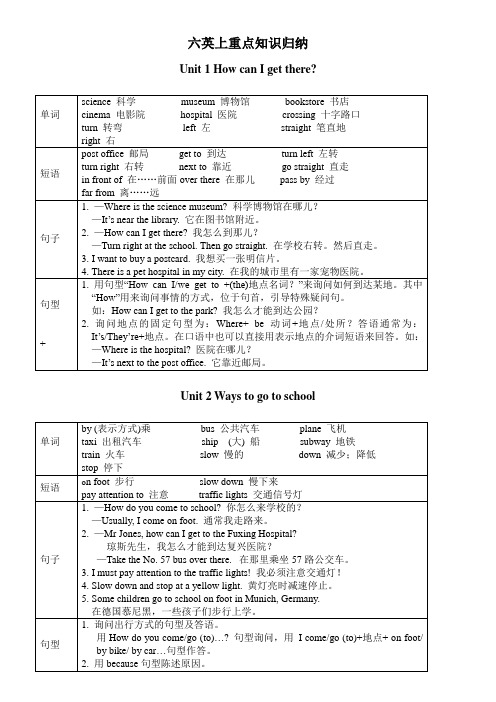
他喜欢猜字谜和远足吗?
—Yes, he does.是的,他喜欢。
句型
1.询问爱好的句型
固定句型:What is/are +one’s+ hobby/hobbies? (……有什么爱好?)
答语:人+like(s) doing…(……喜欢做……)
—She is a nurse.她是一名护士。
2.用句型“Where does+主语(第三人称单数)+work?”询问某人的工作地点。用句型“主语(第三人称单数)+works +(表示地点的)介词短语。”回答。如:
—Where does your father work?你爸爸在哪儿工作?
—He works in a car factory.他在一家汽车工厂工作。
wash clothes洗衣服draw pictures画画
make a snowman堆雪人go for a picnic去野餐
句子
1.—What are you going to do tomorrow?你明天打算做什么?
—I’m going to have an art lesson.我要上美术课。
5. Some children go to school on foot in Munich, Germany.
在德国慕尼黑,一些孩子们步行上学。
句型
1.询问出行方式的句型及答语。
用How do you come/go (to)…?句型询问,用I come/go (to)+地点+ on foot/ by bike/ by car…句型作答。
六年级上册英语1-4单元必考知识点总结

Unit 3 What are you going to do?
一.词汇 'next week 下周
newsp叩er 报纸
this morning 今天上午
comic book漫画书
Time: (时间)
this afternoon 今天下午 this evening今天晚上
magazine 杂志 dictionary 字典
make kites (making kites )制作风筝 colLect stamps (collecting stamps)集邮
三单
Live (lives)居住,住 teach (teaches)教 go (goes)去 watch (watches)看 read (reads)读
其他show (展览)
(交通工具前加by,表示乘坐但步行要用on foot)
三会一
fifth第五 difference 不同 country 国家 right右边的 Australia澳大利亚 if如果
remember 记住 same相同的 mean意思是
side 边 however 但是 must必须
find找到 every每个所有的 drive驾驶
do (does) pen pal(笔友)
dear (亲爱的)
look(看上去)fun(快乐,乐趣)
with(同…)
三、重点句型:
1 .询问某人的爱好:
---------- What's your hobby?你的爱好是什么?
-----------1 Like collecting stamps.我喜欢集邮 2 .表示征求别人意见:
我坐飞机去。
■ ----------- How does your father go to work? ----------- He goes to work by subway.
六年级上英语知识点汇总
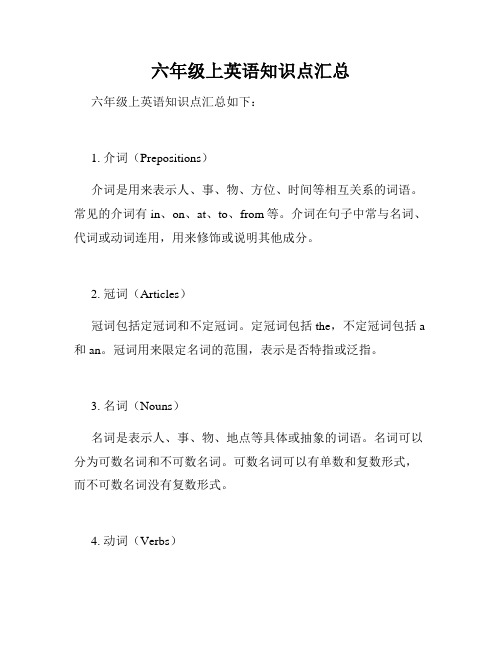
六年级上英语知识点汇总六年级上英语知识点汇总如下:1. 介词(Prepositions)介词是用来表示人、事、物、方位、时间等相互关系的词语。
常见的介词有in、on、at、to、from等。
介词在句子中常与名词、代词或动词连用,用来修饰或说明其他成分。
2. 冠词(Articles)冠词包括定冠词和不定冠词。
定冠词包括the,不定冠词包括a 和an。
冠词用来限定名词的范围,表示是否特指或泛指。
3. 名词(Nouns)名词是表示人、事、物、地点等具体或抽象的词语。
名词可以分为可数名词和不可数名词。
可数名词可以有单数和复数形式,而不可数名词没有复数形式。
4. 动词(Verbs)动词是表示动作或状态的词语。
动词分为实义动词和系动词。
实义动词表示具体的动作或行为,而系动词用于连接主语和表语,表示状态或特征。
5. 形容词(Adjectives)形容词是用来描述名词性质或特征的词语。
形容词通常放在名词前面,用于修饰名词。
6. 副词(Adverbs)副词是用来修饰动词、形容词、副词和全句的词语。
副词可以表示时间、地点、方式、程度等。
7. 人称代词(Personal Pronouns)人称代词用来代替特定的人或事物。
常见的人称代词有I、you、he、she、it、we、they等。
8. 物主代词(Possessive Pronouns)物主代词用来表示所属关系,替代名词后面的所有格形式。
常见的物主代词有mine、yours、his、hers、ours、theirs等。
9. 时态(Tenses)英语中的时态用来表示动作或状态发生的时间。
常见的时态有一般现在时、一般过去时、一般将来时等。
10. 句型(Sentence Patterns)句型是指一种符合语法规则的句子的结构形式。
常见的句型有陈述句、疑问句、祈使句、感叹句等。
11. 单词拼写(Spelling)六年级的英语学习中,需要掌握的词汇量逐渐增多。
学生需要通过进行拼写练习,提高单词拼写的准确性。
六年级上册英语一到四单元知识点
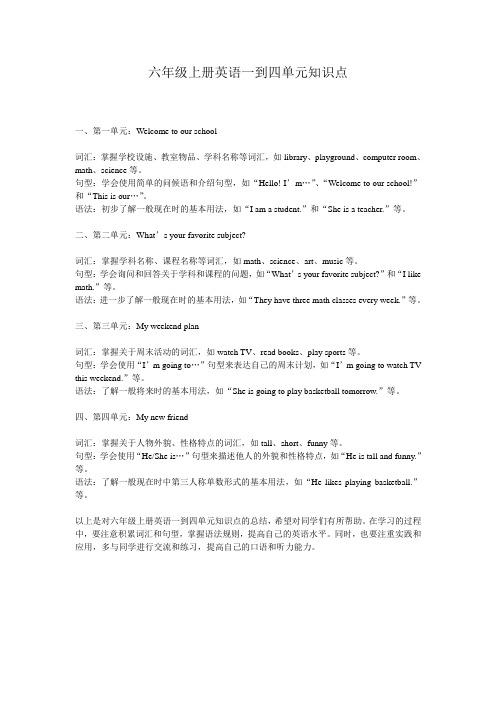
六年级上册英语一到四单元知识点一、第一单元:Welcome to our school词汇:掌握学校设施、教室物品、学科名称等词汇,如library、playground、computer room、math、science等。
句型:学会使用简单的问候语和介绍句型,如“Hello! I’m…”、“Welcome to our school!”和“This is our…”。
语法:初步了解一般现在时的基本用法,如“I am a student.”和“She is a teacher.”等。
二、第二单元:What’s your favorite subject?词汇:掌握学科名称、课程名称等词汇,如math、science、art、music等。
句型:学会询问和回答关于学科和课程的问题,如“What’s your favorite subject?”和“I like math.”等。
语法:进一步了解一般现在时的基本用法,如“They have three math classes every week.”等。
三、第三单元:My weekend plan词汇:掌握关于周末活动的词汇,如watch TV、read books、play sports等。
句型:学会使用“I’m going to…”句型来表达自己的周末计划,如“I’m going to watch TV this weekend.”等。
语法:了解一般将来时的基本用法,如“She is going to play basketball tomorrow.”等。
四、第四单元:My new friend词汇:掌握关于人物外貌、性格特点的词汇,如tall、short、funny等。
句型:学会使用“He/She is…”句型来描述他人的外貌和性格特点,如“He is tall and funny.”等。
语法:了解一般现在时中第三人称单数形式的基本用法,如“He likes playing basketball.”等。
六年级上英语知识点归纳总结
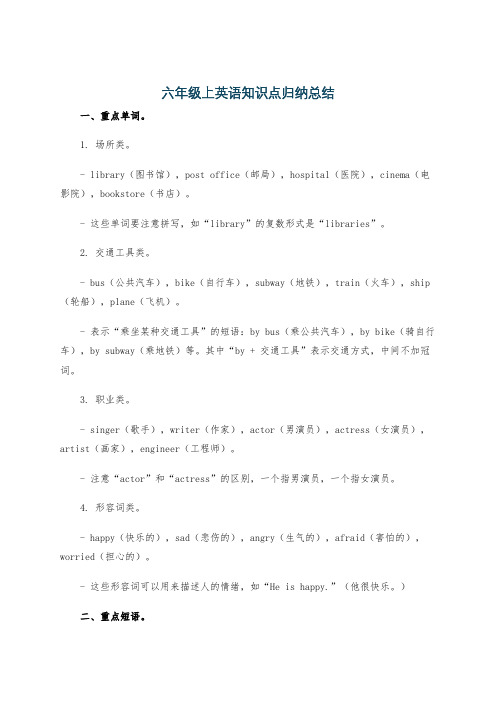
六年级上英语知识点归纳总结一、重点单词。
1. 场所类。
- library(图书馆),post office(邮局),hospital(医院),cinema(电影院),bookstore(书店)。
- 这些单词要注意拼写,如“library”的复数形式是“libraries”。
2. 交通工具类。
- bus(公共汽车),bike(自行车),subway(地铁),train(火车),ship (轮船),plane(飞机)。
- 表示“乘坐某种交通工具”的短语:by bus(乘公共汽车),by bike(骑自行车),by subway(乘地铁)等。
其中“by + 交通工具”表示交通方式,中间不加冠词。
3. 职业类。
- singer(歌手),writer(作家),actor(男演员),actress(女演员),artist(画家),engineer(工程师)。
- 注意“actor”和“actress”的区别,一个指男演员,一个指女演员。
4. 形容词类。
- happy(快乐的),sad(悲伤的),angry(生气的),afraid(害怕的),worried(担心的)。
- 这些形容词可以用来描述人的情绪,如“He is happy.”(他很快乐。
)二、重点短语。
1. 问路相关。
- turn left(向左转),turn right(向右转),go straight(直走)。
- 例如:“Go straight and then turn left at the second crossing.”(直走然后在第二个十字路口左转。
)2. 兴趣爱好相关。
- read books(读书),see a film(看电影),take a trip(去旅行),go hiking(去远足)。
- 例如:“I like to read books on weekends.”(我喜欢在周末读书。
)三、重点句型。
1. 询问地点。
- Where is the + 地点?例如:“Where is the post office?”(邮局在哪里?)- 回答:It's + 方位介词短语。
六年级上册英语常用知识点
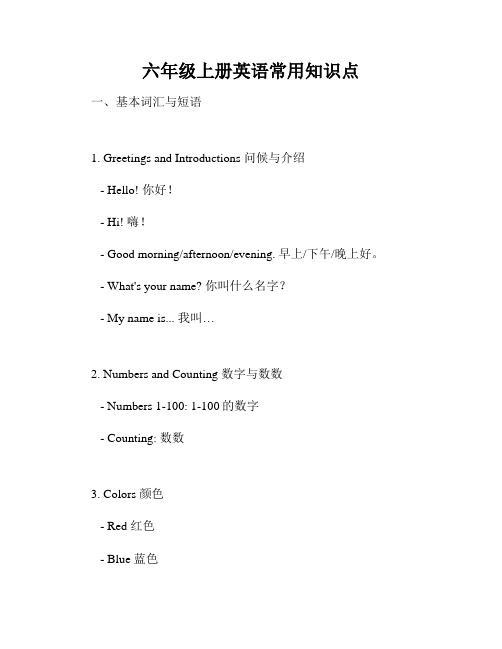
六年级上册英语常用知识点一、基本词汇与短语1. Greetings and Introductions 问候与介绍- Hello! 你好!- Hi! 嗨!- Good morning/afternoon/evening. 早上/下午/晚上好。
- What's your name? 你叫什么名字?- My name is... 我叫…2. Numbers and Counting 数字与数数- Numbers 1-100: 1-100的数字- Counting: 数数3. Colors 颜色- Red 红色- Blue 蓝色- Green 绿色- Yellow 黄色- Orange 橙色- Purple 紫色4. Days of the Week and Months of the Year 星期与月份 - Days of the Week: 星期- Months of the Year: 月份5. Family 家庭- Mother 母亲- Father 父亲- Sister 姐妹- Brother 兄弟二、基本语法1. Simple Present Tense 现在简单时- Affirmative, Negative, and Interrogative sentences: 肯定句、否定句、疑问句- Third person singular: 第三人称单数2. Present Continuous Tense 现在进行时- Affirmative, Negative, and Interrogative sentences: 肯定句、否定句、疑问句3. Question Words 疑问词- Who? 谁?- What? 什么?- When? 什么时候?- Where? 在哪里?- Why? 为什么?- How? 如何?4. Prepositions 介词- In, On, Under, Next to, Between: 在…里,在…上,在…下,在…旁边,在…之间三、日常用语与交际技巧1. Asking for Help 请求帮助- Could you please help me? 你能帮个忙吗?- Can you show me...? 你能给我看看…吗?- I need your assistance. 我需要你的帮助。
六年级英语上册知识点汇总
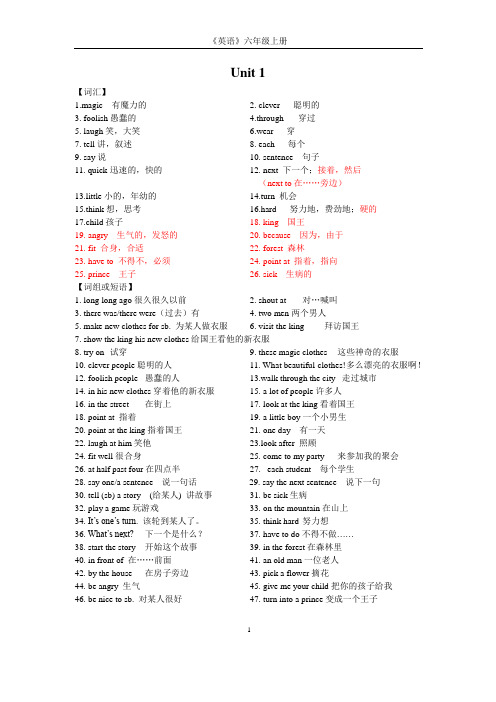
Unit 1【词汇】1.magic 有魔力的2. clever 聪明的3. foolish愚蠢的4.through 穿过5. laugh笑,大笑6.wear 穿7. tell讲,叙述8. each 每个9. say说10. sentence 句子11. quick 迅速的,快的12. next 下一个;接着,然后(next to在……旁边)13.little小的,年幼的14.turn 机会15.think想,思考16.hard 努力地,费劲地;硬的17.child孩子18. king 国王19. angry 生气的,发怒的20. because 因为,由于21. fit 合身,合适22. forest 森林23. have to 不得不,必须24. point at 指着,指向25. prince 王子26. sick 生病的【词组或短语】1. long long ago很久很久以前2. shout at 对…喊叫3. there was/there were(过去)有4. two men两个男人5. make new clothes for sb. 为某人做衣服6. visit the king 拜访国王7. show the king his new clothes给国王看他的新衣服8. try on 试穿9. these magic clothes 这些神奇的衣服10. clever people聪明的人11. What beautiful clothes!多么漂亮的衣服啊!12. foolish people 愚蠢的人13.walk through the city 走过城市14. in his new clothes穿着他的新衣服15. a lot of people许多人16. in the street 在街上17. look at the king看着国王18. point at 指着19. a little boy一个小男生20. point at the king指着国王21. one day 有一天22. laugh at him笑他23.look after 照顾24. fit well很合身25. come to my party 来参加我的聚会26. at half past four在四点半27. each student 每个学生28. say one/a sentence 说一句话29. say the next sentence 说下一句30. tell (sb) a story (给某人) 讲故事31. be sick生病32. play a game玩游戏33. on the mountain在山上34. It’s one’s turn.该轮到某人了。
- 1、下载文档前请自行甄别文档内容的完整性,平台不提供额外的编辑、内容补充、找答案等附加服务。
- 2、"仅部分预览"的文档,不可在线预览部分如存在完整性等问题,可反馈申请退款(可完整预览的文档不适用该条件!)。
- 3、如文档侵犯您的权益,请联系客服反馈,我们会尽快为您处理(人工客服工作时间:9:00-18:30)。
人教版(PEP)小学英语总复习六年级上册知识点Unit 1 How can I get there ?一、主要单词:museum博物馆bookstore书店cinema电影院turn 转弯hospital医院left向左post office 邮局science科学right向右straight笔直地crossing十字路口二、习惯语搭配:post office邮局science museum科学博物馆pet hospital宠物医院Italian restaurant意大利餐馆Beihai Park北海公园Palace Museum故宫博物院go straight直走turn right/left右/左转next to挨着in front of...在...前面near the park在公园附近on Dongfang Street在东方大街上三、惯用表达式:Excuse me 打扰一下Follow me, please!请跟着我!四、公式化句型:1、问路的句型及其答语:问句:Where is the + 地点?···在哪儿?问句:How can +主语+ get (to)+地点?···怎么到···?同义句型:Can you tell me the way to +地点?Where is + 地点?Which is the way to +地点?Where is the cinema, please? 请问电影院在哪里?It’s next to the hospital. 它与医院相邻。
Turn left at the cinema, then go straight. It’s on the left.在电影院向左转,然后直行。
它在左边。
Turn left at the bank。
在银行左转。
六、主题写作:范文How to Get to the Science MuseumWe are going to the science museum tomorrow.The science museum is next to the hospital.It’s not far from our school.So we can go there on foot.First,go straight from our school.Next,turn left at the post office and walk for about five minutes.Then turn right at the bookstore.We can find the hospital on the right.Walk straight,and we’ll see the science museum.Unit 2 Ways to go to school一、主要单词:by乘bus公共汽车on foot步行plane飞机taxi出租车ship(大)船subway地铁train火车slow慢的stop停下 always 总是,一直 usually 通常often经常sometimes 有时候 never 从来不二、习惯语搭配:by bike/bus/plane/subway/train/ship/taxi/ferry骑自行车/乘公共汽车/飞机/地铁/火车/船/出租汽车/渡轮take the No.57 bus乘57路公共汽车on foot步行slow down慢下来pay attention to注意traffic lights 交通信号灯look right向右看cross the road横穿马路get off下车at home在家traffic rules 交通规则 get to到达get on 上车be far from…表示离某地远三、惯用表达式:Wait!等一等!Hooray太好了!I see. 我明白了。
Go at a green light 绿灯行Stop at a red light 红灯停Wait at a yellow light 黄灯等四、公式化句型:1、如何询问对方的出行方式:How do you come(to)+地点?你(们)怎么来···的?2、如何用must表示必须做某事:某人+must+动词原形(+其它). ···必须···。
3、告诫别人不要做某事的句型:Don’t +动词原形(+其它). .不要/别···。
五、例句:How do you go to school? 你怎么去上学?Usually I go to school on foot. Sometimes I go by bus.通常我步行去上学。
有时候骑自行车去。
How can I get to Zhongshan Park ? 我怎么到达中山公园?You can go by the No. 15 bus. 你可以坐15路公共汽车去。
I am far from school now. 我现在离学校很远。
My home is not far from our school. My home is near our school.我家离学校不远。
六、主题写作:范文Don’t Be Against the Traffic RulesI go to school from Mondays to Fridays. I go to school by bike at 7:30 in the morning.I have to cross two busy roads.I know the traffic rules well.Slow down and stop at a yellow light.Stop and wait at a red light.Go at a green light.I always ride on the right side of the road.I am never against the traffic rules.Unit 3 My weekend plan一、主要单词:tomorrow明天film电影supermarket超市trip旅行tonight在今晚evening晚上/傍晚next week下周comic连环画杂志dictionary词典word单词post card明信片visit拜访二、习惯搭配:take a trip去旅行go for a picnic去野餐go to the cinema去看电影learn to swim学习游泳visit my grandparents看望我(外)祖父母get together 聚会go to the supermarket去超市go ice-skating去滑冰make a snowman堆雪人see a film看电影make mooncakes做月饼read a poem朗诵一首诗this weekend这周末Renmin Park人民公园next week下周this morning/afternoon/evening今天上午/下午/晚上next Wednesday下星期三三、惯用表达式:What about you?你呢?Here they are!它们在这儿!Can I help you?我能帮助你吗?Sounds great!听起来很棒!Have a good time!玩得开心!You too.你也是四、公式化句型:1、询问对方打算做什么的句型及其答语:问句:Where are you going(+将来时间)? 你/你们打算(···)去哪儿?答语:I’m/We’re going (to the)+地点. 我/我们打算去···。
3、询问对方打算何时去做某事的句型及答语:问句:When are you going to +动词(短语)原形?你/你们打算什么时候···?答语:I’m/We’re going to +动词(短语)原形+将来时间. 我/我们打算···。
五、例句:What are you going to do on the weekend? 你周末打算做什么?I’m going to visit my grandparents this weekend? 这个周末我打算去看望我的外祖父母。
Where are you going this afternoon? 你今天下午打算去哪里?I’m going to the bookstore. 我打算去书店。
What are you going to buy? 你打算去买什么?I’m going to buy a comic book。
我打算去买一本漫画书。
六、主题写作:范文Let’s Have a Nice Day!Today is Saturday.Tomorrow morning I’m going to the bookstore with my friends.We are going to look for some good books.We all like reading books.We are going to have lunch in a restaurant.I like chicken,beef and vegetables.After lunch,we are going to the Summer Palace by bus.We are going to play near the Kunming Lake.Maybe we are going to row a boat on the lake.That will be great!We are coming back at 5 in the afternoon.Unit 4 I have a pen pal一、主要单词:studies学习(第三人称单数形式)puzzle谜hiking远足二、习惯搭配:read stories读故事do kungfu练功夫fly kites放风筝play the pipa弹琵琶play sports进行体育活动climb mountains爬山listen to music听音乐sing English songs唱英文歌on a farm在一个农场里live in...住在···write an email to...给···写一封电子邮件on the playground在运动场上三、惯用表达式:Me too.我也是。
